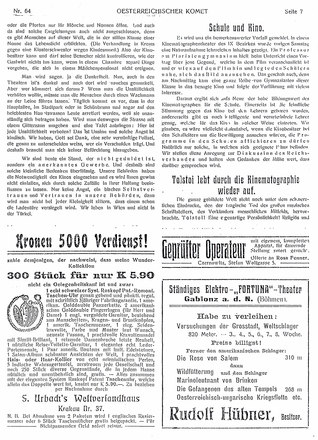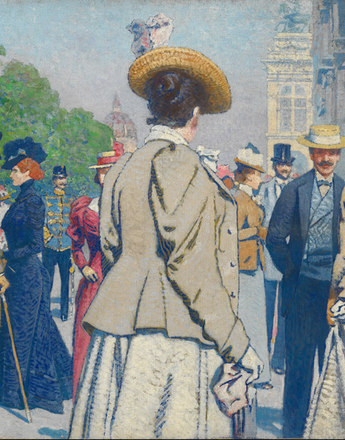Combatting ‘dirt and trash’
The call for ‘good’, ‘morally elevating’ films with an instructive rather than an entertaining and voyeuristic element became more strident around 1906 as the medium began to spread. A debate initiated by the educated middle classes about the danger of ‘trashy films’ resulted in the establishment of the cinema reform movement, which stood for ‘better’, ‘morally superior’ and instructive film-making.
The cinema reform movement set its sights particularly on ‘film dramas’, in other words films in general with a dramatic narrative, particularly love stories, crime movies, adventure and sensation films. The reformers saw a ‘danger for the uneducated masses’, by which they meant especially children, juveniles and women. They even claimed that women were ‘addicted to the cinema’. Women’s associations also mobilized against ‘cinematographic immorality’. In 1909 the Catholic Women’s Organization of Moravia protested against ‘Paris evenings’ or ‘gentlemen’s evenings’, which it claimed were degrading to women. The pressure from these associations to prevent the distribution of ‘dirt and trash’ became stronger after 1909 and ultimately compelled the authorities to act. In summer 1909 all ‘cinematographic theatre pictures which violated the sense of decency and shame’ were banned in Bohemia.
The main focus was always on the protection of children and juveniles from ‘socially and morally destabilizing potential’, which many films and indeed the cinematographic environment in general were said to harbour. School representatives criticized the way in which film narrators described the films, which often ‘corrupted public morals’. In 1916 the school authorities banned juveniles under 16 years of age from visiting cinematographic performances, with the exception of educational films, which the cinema reformers saw as a useful way of communicating knowledge. The cinema magazine Der Komet (no. 1184, 1907) stated, for example, in a report on ‘education through cinematographs’: ‘The organization of school presentations with a selected programme, the introduction of live photography as an educational aid for schools and the promotion in particular of interest in instructive films – this should be the purpose of pictures with natural history, industrial and ethnological subjects, which are without a doubt of greater value and better educational effect than many of the tasteless products offered today.’
With this in mind, the Central Office for Scientific and Educational Cinematography was founded in Vienna in 1912 to ‘keep a record of all existing scientific films’, organize their distribution and promote the production of suitable material. The introduction of school performances in ‘better cinemas’ was planned for autumn 1912 in cooperation with the Reich Association of Cinematograph Owners. After the First World War the cinema reform movement was revived and was also successful in Austria, for example, through the establishment of a series of large school cinemas in Vienna in the 1920s.
Translation: Nick Somers
Achenbach, Michael: Die Geschichte der Firma Saturn und ihre Auswirkungen auf die österreichische Filmzensur, in: Achenbach, Michael/Caneppele, Paolo/Kieninger, Ernst: Projektionen der Sehnsucht. Saturn. Die erotischen Anfänge der österreichischen Kinematografie, Wien 1999, 75-102
Ballhausen, Thomas: Geschnitten, Verboten, Vernichtet. Notizen zur österreichischen Filmzensurgeschichte bis 1938, in: Biblos 51 (2002), 203-214
Schlüpmann, Heide: Zur heimlichen Komplizenschaft zwischen Kinematografie und Frauenemanzipation in der wilhelminischen Gesellschaft, in: Schlüpmann, Heide: Die Unheimlichkeit des Blicks. Das Drama des frühen deutschen Kinos, Frankfurt am Main 1990, 8-23
-
Chapters
- Film censorship – regulating what was shown
- The Saturn censorship affair
- Combatting ‘dirt and trash’
- Serving the public – the film and cinema industry before and during the First World War
- Organized propaganda: the film department of the War Press Office
- Focuses and aims of war film propaganda
- After the war – the National Film Headquarters: managing the past, warning about the present, and promoting new ideas






